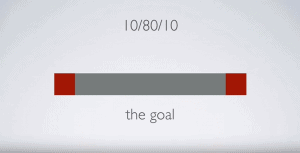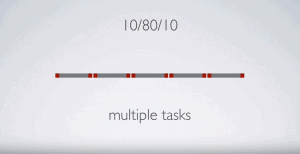What can the 80/20 rule do for your business?
Mike shares scenarios of simplification through outsourcing tasks to specialists and you handling the work that you love to do.
Discover the depth and richness of the 80/20 rule from this systemHUB live workshop? Sign up today for your free systemHUB trial – click here.
Video transcript:
Let’s go through those seven. We’ll start at 10:80:10. This is my version of the 80:20 rule. I love the 80:20 rule. A lot has been written about it recently. I paid a boatload of money to go and see Richard Koch speak in Chicago last year with Perry Marshall. He’s the original 80:20 guy. It’s all about simplicity and simplifying business.
Pick a task. In your head, think of something relatively simple in your business that you would like to get off your plate. The red represents the work that you do, the grey is what that other person might do. Right now you might just hand that over, because outsourcing to the Philippines may seem too hard, it’s too complicated. I’ve got to go hire the person, how do I do that?
Maybe this is just handing it off to your 2IC in your office wherever you are. You would love to hand the whole task off, but that is just not feasible at this point. So you hand off a little bit. Over time, maybe you can grow how much of that task they do. Like Dave was saying before, they get a little bit better, a bit more training, they use the system, you improve the system. You hand off a bit more, you hand off a bit more.
Then you realize there is this thing called correcting. This person that you’re handing all this work to doesn’t do it as well as you. This is probably the hardest part about doing this. The hardest part about delegating is remembering that when you started doing this, you were pretty bad at it too and you didn’t have those systems. You’ve got to give them a little bit of time to get good.
When we get to module three, what I want to think about is to change this from correcting to coaching and mentoring.
Maybe this is just handing it off to your 2IC in your office wherever you are. You would love to hand the whole task off, but that is just not feasible at this point. So you hand off a little bit. Over time, maybe you can grow how much of that task they do. Like Dave was saying before, they get a little bit better, a bit more training, they use the system, you improve the system. You hand off a bit more, you hand off a bit more.
If that looks reasonable, this is the goal. This is the most important bit you can do. It is defining what that work looks like. Does anyone know Scrum, the software devs in the room? The definition of done, the term that gets used in Scrum. A lot of Scrum methodology is being used more and more. It’s a great project management tool.

80:20 Rule
Scrum is all about the definition of done. How do I know when I’ve done it and done it well?
So your job up here is to put the input into the system to give them the tools and resources that they need and to give them the system so that they can go do the bulk of the work for you. Then they come back at the end and hand this back to you. It should be perfect. It’s not going to be perfect the first few times. Your job then is coaching and mentoring, helping them get better and better over time.
So that grey part in the middle grows and grows. If you can hand over 80% of your workload, how does life feel? Aah!
It also makes you far more efficient. If that’s too hard to get your head around, think about breaking that big task into smaller chunks. You would kick things off, lob the input into the system and they’d come back around. I think someone calls these pause points. They come back around and almost check in with you.
This is what I’ve done so far, boss. How are we going? Yes, tweak that, tweak that. Now here’s the next part of the system, off you go and do that. They check in with you again. Yes, actually we’re on track. This is really good. Lob that into the final part of the system and off you go.
The key thing with project Hourglass is realizing these don’t have to be the same people all the way through. Your job may be just to check out that blog post and lob it on to your writer. They come back and then you go off to your illustrator or your graphics person. They go and collect all your screen grabs and tidy up all the images and do all that. Then maybe you’ve got a doer at the end here who posts it and distributes it. He distributes it across the web or posts your Facebook post or whatever it might be.
They are different specialties. You are not trying to get all these vastly different skills in one brain who you hire for forty hours a week. That is getting harder and harder to do. Hire someone for five hours a week or three hours a week or fifteen hours a week to do that special task. You can obviously do more and more of those. Then you can start to go the other way. It’s

80:20 Rule
fractal, just like 80:20. This represents the person doing the work. This is you. They do the work and they hand it back to you. What we then realised was this was my 2IC here in Melbourne. I can actually hand the task to her and she could start to hand off eighty percent of what she does. This is a high-ish level thinking level. This is more following checklists and getting work done. So then she’s got 10:80:10 on her work. Now she is five times more efficient. She’s handing off work.
Even within this, we then started to realise there is a 10:80:10 in here. That middle 80% we hand off to a computer. That’s the bit that is completely automated. This person looks after the automation, they hand the work back. Yes, that’s all good. They hand it back to me that’s fine, keep going.
Have a think how you can use something like this in your business: 10:80:10. The most important job is that first ten percent. That is defining what needs to be done, giving them the resources and getting you out of the way. You are probably the bottle neck most of the time. You’re sitting on that idea and until you get that first bit off your plate, not trying to do it perfectly, just giving the brief to someone else and saying off, you go, get them running.
Want to explore how you can put the 80/20 rule into action immediately? Sign up today for your free systemHUB trial – click here.










